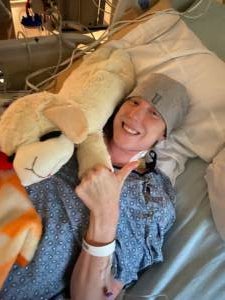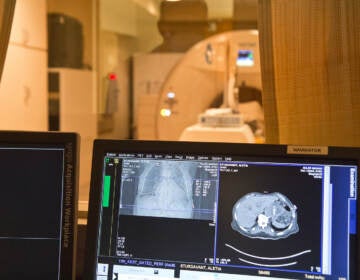Life after a shock: Why heart patients need access to mental health care
An implantable defibrillator can save patients who have unusual heart rhythms. But some of them also need help to deal with painful and anxiety inducing shocks.
Listen 12:32
Ashley Yeager always loved to swim, but had to adjust after being diagnosed with a serious heart rhythm condition. (Courtesy of Allison Martin-Attix)
This story is from The Pulse, a weekly health and science podcast.
Find it on Apple Podcasts, Spotify, or wherever you get your podcasts.
Science writer Ashley Yeager always loved to swim. She swam as a kid, and then competitively in college, and eventually started to do triathlons.
In 2011, she volunteered to participate in a study of triathletes, which involved taking some ultrasound pictures of her heart.
“I thought it was just so awesome that you could see this organ that keeps you alive,” Yeager said. “I was so focused on thinking about how the heart works … that it didn’t really dawn on me to be concerned that the tech went to go get a doctor.”
The doctor did an additional test, then recommended she see a cardiologist. That’s how, at age 26, Yeager found out she had a very serious heart condition called arrhythmogenic right ventricular cardiomyopathy. It’s a disease where a person’s scar tissue replaces their heart muscle tissue, which disrupts the electrical signal telling their heart to pump blood.
Yeager started taking medicine to keep the unusual heart rhythms at bay and had a defibrillator implanted in her chest. It’s connected to her heart, and if her heart gets into an abnormal rhythm, the device shocks her heart back to a normal rhythm.
For about five years, her life didn’t really change all that much. She was still doing what she loved: exercising.
She moved from North Carolina to New York City. And there, for the first time, the defibrillator shocked her heart.
“It is like an animal kicking you in the chest from the inside out. And it’s very painful and surprising,” Yeager said.
Subscribe to The Pulse
Not all patients with implantable defibrillators experience this — the device is supposed to be an insurance policy to save them from unusual heart rhythms, just in case. The chances of getting a shock vary based on a patient’s condition and success of other medical treatments.
After that first traumatic shock, Yeager paid more attention to symptoms, and to how she had changed.
“When I would take the subway and climb the stairs from the bottom to reach street level, I noticed that I would get out of breath really easily … I would try to write it off as like: I walked a lot or I’m tired. But looking back on it, I think those were the very early signs.”
The shocks started happening more frequently, about once a month. One time she got shocked three times in a row, and she had to go to an emergency room to get her heart checked.
Her doctor also told her to slow down her physical exercise routines —no running, swimming, rigorous biking, or racing.
“Basically, you have to change your whole way of life. So, I think there was a bit of an identity crisis at the beginning … just trying to figure out: how do I navigate this world without athletics? Because that was my stress reliever and my social outlet.”
The condition took a larger and larger toll on her life.
One time, in 2021, when she was on a beach in Miami, her heart was beating 180 times a minute, according to her Apple watch. She expected to get a shock from the defibrillator, but it never came.
It turns out later she had taken so much medicine to keep her heart rhythms in check that even though her heart was racing, she had not quite gotten to the point where her defibrillator shocked her.
But, then, she couldn’t think clearly, her breathing got quicker, and her husband called an ambulance.
“While I was in the ambulance, they were not able to control my arrhythmia with medicine, so they had to actually put the paddles of life … to me while I was awake. And it was the most excruciating pain that I have ever been through. I don’t think I’ve ever screamed so loud. And just afterwards I remember the smell of burnt flesh and just feeling totally helpless and out of control.”
In early 2022, Yeager was in the hospital again for a surgery to ease some of her heart rhythm issues. She was still shaken by all that had happened, and asked the doctors for mental health support.
The hospital had recently hired a cardiac psychologist — somebody trained to work with people on the mental health issues that can come with heart conditions.
She started seeing that psychologist, and worked on things that gave her anxiety — like thinking about being shocked in the ambulance every time she heard sirens.
Talking to the psychologist also helped her deal with the completely unpredictable nature of her condition: not knowing when her heart rhythm would change, and why or when the next shock would come.
“Many people like to be in control of things. And so when you have a heart condition, and specifically with my condition, where the rhythm could change at any minute without any impetus, that was really, really hard to accept,” said Yeager.

It is hard for patients to learn that these shocks are random, and to not connect the shocks to whatever they were doing at the time. For instance, Sam Sears, a clinical health psychologist at East Carolina University, often cites this example: “A patient with an implantable defibrillator receives a shock in the shower and is terrified … paramedics come in and they’re horribly embarrassed by it. So thereafter, everything’s stabilized, the patient’s fine and they come back home and they say, ‘I’m not taking any more of those showers.’”
He uses this example to explain why heart patients need help not just dealing with their physical health, but also their mental health.
Hundreds of thousands of people in the U.S. have these implantable defibrillators. And they have reported depression, anxiety, and post traumatic stress tied to the shocks, even though the shocks keep them alive.
“When medicine makes progress, it leaves psychologic change in its wake,” Sears said. “So, we help our patients survive disease, but then we got to help our patients make sense of all that and continue to move forward.”
Several health psychologists and a cardiologist said that ideally, when a patient comes in for a visit, they would see a cardiologist to take care of their heart, a technician if they have a defibrillator, and a cardiac psychologist to check on their mental health needs. The American Heart Association put out a statement saying that heart patients in general, not just the ones with implanted defibrillators, need access to this kind of care.
But the change has been frustratingly slow, said Adrienne Kovacs, a clinical and health psychologist who trained under Sam Sears. She has worked in hospitals in the U.S. and Canada, and is now in private practice in Toronto.
“Cardiovascular programs in hospitals … invest in what they prioritize,” Kovacs said. “We need for them to decide that addressing patients’ psychological needs is an essential component of cardiovascular care.”
At Oregon Health and Science University, she worked with Babak Nazer, a cardiac electrophysiologist, a specialist in treating heart rhythm issues. At the end of each patient visit, Nazer would refer patients to check in with her to address any psychological symptoms they might have.
“We had a script for our schedulers to read to patients that made it very obvious that we didn’t think they had a psychological disease, but that all patients, frankly, all humans have some degree of psychological symptoms, and this visit was offered to all the patients,” Nazer said.
The clinical staff cleared it with insurance to make sure that cost would not be an issue.
Nazer said that some patients would see Kovacs, the psychologist, once, and decide that they were doing well, and did not need to see a psychologist again. Some patients chose to see them together in the next visits.
And then there were some patients who were doing well physically, but the memory of their last shock from the defibrillator stuck with them, and they wanted to see the cardiac psychologist more often than their heart rhythm specialists.
Last year, Nazer and his colleagues presented their findings at a conference for heart rhythm specialists and are preparing to publish them.
Psychologists, cardiologists, and patients are advocating for more heart patients to have access to specialized mental health care. As patient Ashley Yeager put it, “there’s a lot of … stress and emotion that comes with not being able to control the organ that pumps life into your body.”
After a few years of frequent shocks from her defibrillator, her condition got worse. She had trouble walking or moving and says her life shriveled to just working and surviving.
So she got a heart transplant last year and is doing well. Recently, her doctor even said she can start running again.
“I’m slowly approaching where I was five years ago when the doctors asked me not to do any more exercise,” she said. “It’s one of the most incredible feelings. It’s almost as if I have returned to who I was before I was diagnosed with this condition.”
WHYY is your source for fact-based, in-depth journalism and information. As a nonprofit organization, we rely on financial support from readers like you. Please give today.







